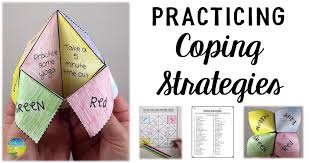Coping Skills Fortune Teller
Suggested Age Group(s): Young, Middle
Purpose: To help kids identify coping skills that can help them feel better when they are sad, angry, etc. Also, the activity can help kids identify coping skills that can connect them to their deceased loved one (e.g. looking at pictures of their loved one).
Task/need: Living on the Grief Spiral, Continued Support
Activity Setup Ideas:
- Ask the group to brainstorm different things big and small that help them feel better when they are sad, mad, etc.
- Explain to the group they are going to make fortune tellers for coping skills. It may be helpful to have an example to show them.
Materials:
- A square piece of paper
- Scissors (if you have to cut your paper into a square)
- Markers, colored pencils, or crayons
- A Pen
Description: This is a take on the paper fortune-tellers some of you probably made as kids, but instead of writing things on the inside like "You will live in a mansion with four dogs" we are going to write coping skills. The idea is that when someone feels sad, stressed, worried, anxious, etc, they can play the fortune-teller game and in the end, they'll get a coping skill they can go do to help themselves feel better.
You can show the kids a video with step by step instructions on how to make the fortune teller: https://youtu.be/koEseodRPJE or follow these directions:
Part One: How to Make a Paper Fortune Teller
You may already know how to make a paper fortune-teller. If so, great, go ahead and make one, but don’t write or draw on it until you get to the next section.
- Step One: Fold a square piece of paper in half.
- Step Two: Open the paper back up and fold in half the other way.
- Step Three: Open the paper back up again, your folds should have divided the paper into four squares.
- Step Four: Now, fold the corner of each square into the center of the paper.
- Step Five: Leaving the paper folded, flip it over.
- Step Six: Once again, fold the four corners into the center of the paper.
- Step Seven: Leaving the paper folded, fold it in half again. Your paper should now look like a rectangle with four square flaps on the outside (see image 7 below).
- Step Eight: Using both hands, slip your thumb and index finger under the flaps.
- Step Nine: Create the fortune-teller shape by pushing up and in at the same time. You may need to fiddle with the center a little as well. Ultimately, the fortune-teller should look something like images 9 (bottom-view) and 10 (top-view) below.

Part Two: Adding Fortunes to Help you Cope
Now, we can't call this a fortune-teller until we’ve written some fortunes inside. But here's the catch, instead of fortunes, we are going to write coping skills. When we talk about coping skills, we mean any big or small thing a person can do to make themselves feel better. These will be unique to the person completing this activity because we all find comfort in different things.
The person completing the activity should be encouraged to brainstorm coping skills that are unique to them. For this activity, the simpler the coping skill, the better (i.e. pet your dog, listen to music, talk to a friend, color, etc). Ultimately, they need to think of 8 coping skills.
If you are an adult completing this activity with a child, encourage them to include at least one coping skill that helps connect them with their deceased loved one. For example, they might include things like looking at pictures of their loved one, thinking about a good memory with their loved one, or doing something that they are their loved one used to do together.
The only rule we have is that the coping skill can not be harmful or destructive to the person completing the activity or to anyone else. We have to clarify this because some coping skills fall under the heading of "negative coping." These are things people do to feel better, but which cause more pain in the long run (like substance use, hitting their brother, or quitting all their school activities)
The coping skills will be written on the inside of the fortune-teller, but first, you also need to put colors and numbers on the outside flaps. When playing the game, these will help determine what coping skills the person lands on. Here's what you need to do:
- Step One: Flatten out your fortune teller. When flat, the fortune-teller should be square. On one side of the square, you will see four smaller squares and on the other, there are triangles.
- Step Two: On the side with the four smaller squares, you are going to put colors. You can either color the whole square, a part of the square, or write the name of the color. It’s up to you.
- Step Three: Flip the fortune-teller over to the side with the triangles. On this side, there are 8 small triangles (within four larger triangles. Within the small triangles, write the numbers 1-8.
- Step Four: Finally, flip over the four larger triangles. In each of the smaller triangles, write one coping skill. You will write down 8 total coping skills.

Playing the game: If you don’t know how to play the game, we recommend watching the video above around the 9-minute mark. It's kind of hard to explain in writing, but basically, the person playing the game will pick a color. The person moving the fortune teller (can be yourself) will spell out the color while pinching and pulling the fortune-teller.
Next, the person playing looks inside the fortune teller and picks a number. The person moving the fortune teller repeats the pinching and pulling while counting to the selected number.
Finally, the person playing will look inside the fortune-teller and select another number. Now the person moving the fortune teller will lift up the flap corresponding to that number and whatever coping skill is written underneath is the coping skill the person should do.
Activity Wrap Up Ideas:
- Ask the group what coping skills would be most helpful to them.
- Process if group members have used the coping skills suggested on the fortune tellers. Did it help you feel better? What helps you the most? Which coping skills would they like to try?
Source: whatsyourgrief.com








